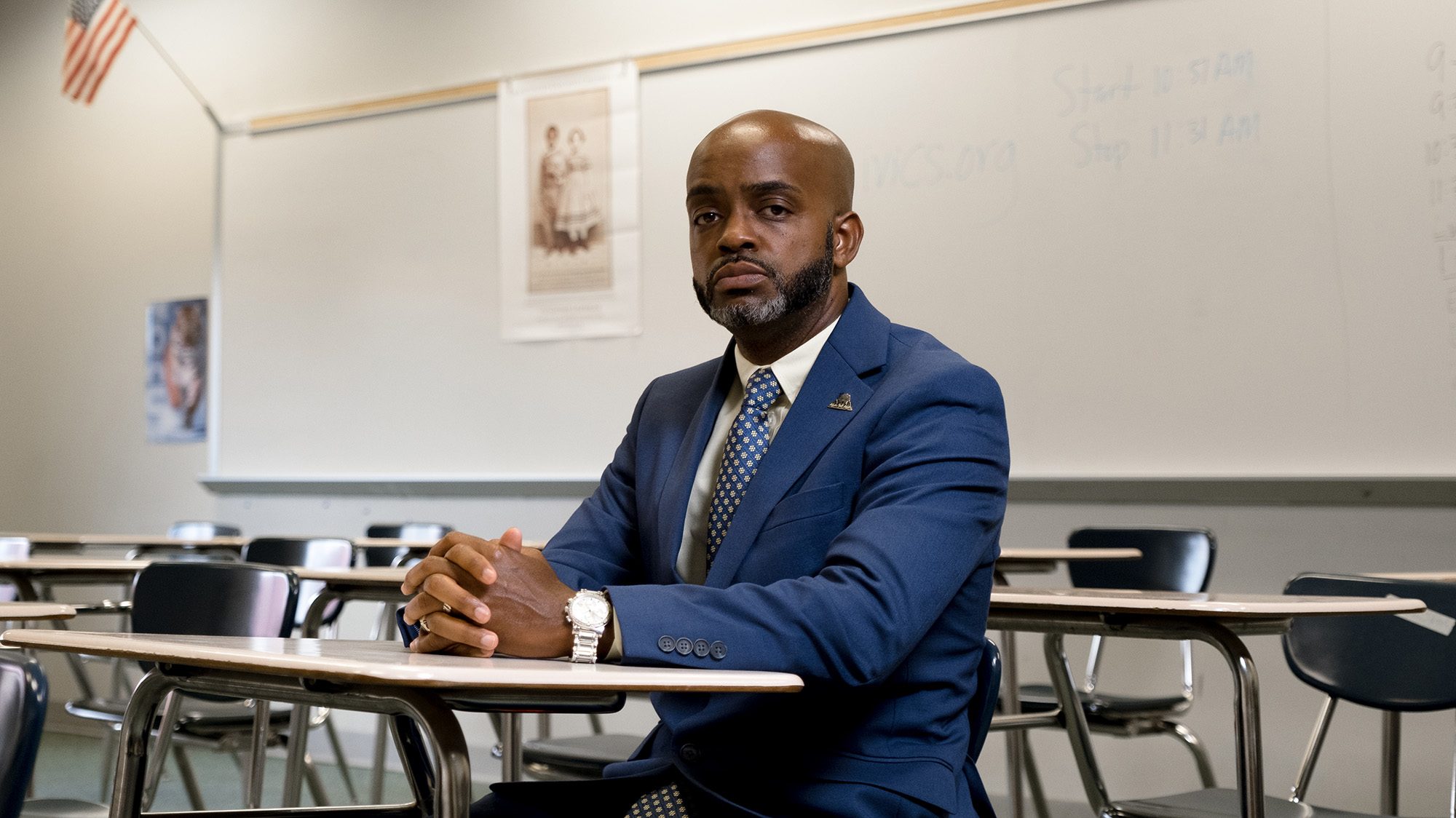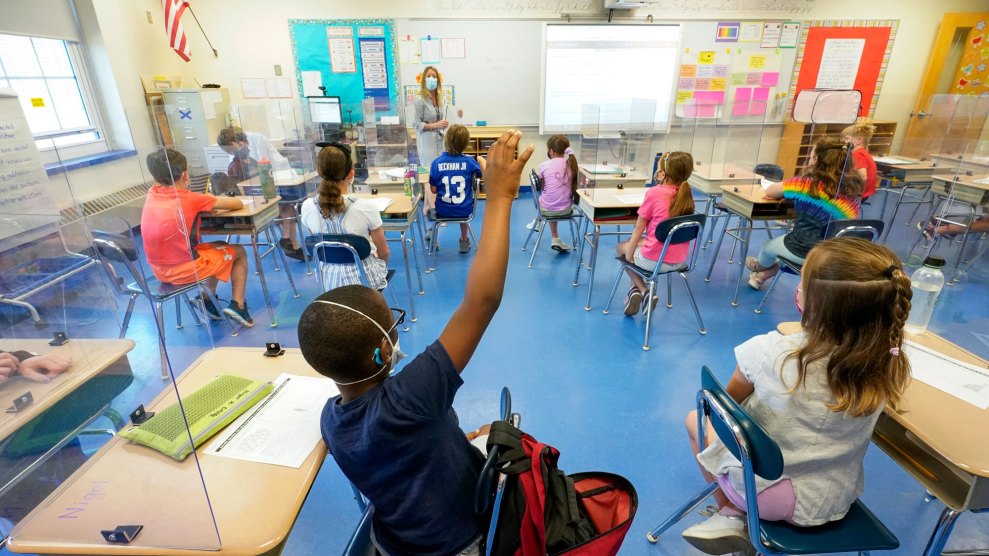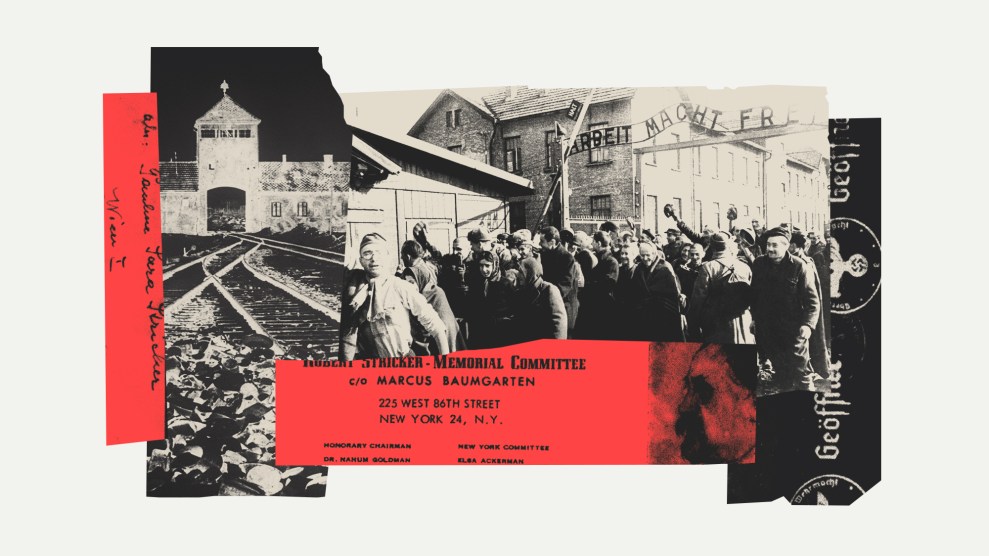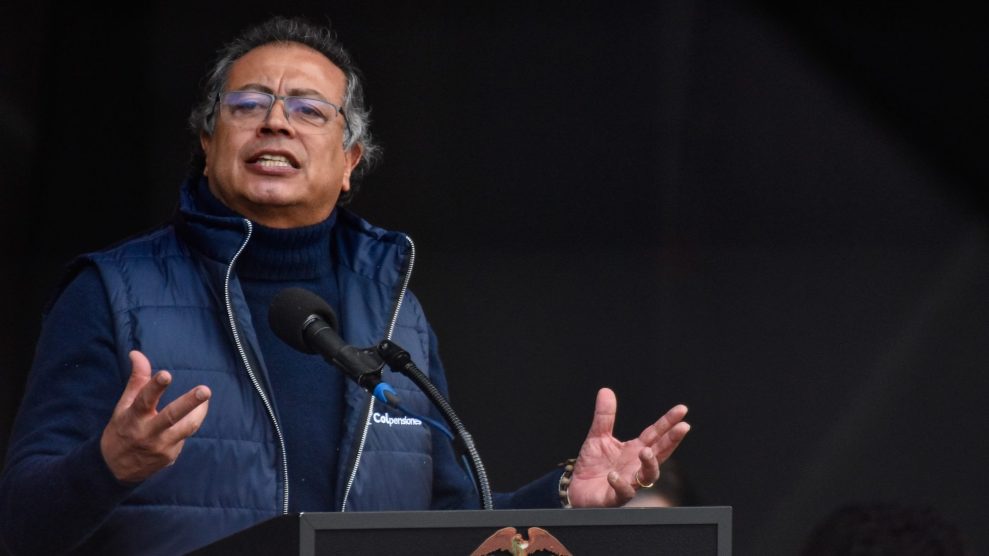In the first week of classes in August, Rodney D. Pierce, a social studies teacher at Red Oak Middle School in Battleboro, North Carolina, set the stage for his 8th graders by sharing a quote from James Baldwin: “American history is longer, larger, more various, more beautiful, and more terrible than anything anyone has ever said about it.” Pierce told the students they were going to learn about both the “beautiful and the horrifying parts” of the state and country’s past. “We need to talk about all of it,” he explained “because that is American history.”
The fight over how to teach American history to children—a long battle that has frothed into a particularly acute moral panic today—often comes back to whose history is being discussed. For Pierce, a Black teacher of many Black students, it’s impossible to avoid racism. For years, he has spoken openly about this in the concrete and the local: the town names, the monuments to Confederates, the horrific lynchings. He has gone above his mandate of teaching to the test because the test did not include the explanations of events that led to the world his students inhabit. He was rewarded by earning social studies teacher of the year in 2019 and has been tasked with helping write the new standards for the state to make sure others follow his lead.
But lately, Pierce’s “speak my truth and be upfront about it” approach has been drawing more backlash than ever before. In the past year, parents have complained to school administrators about a perceived political slant in his work. When he repeated something former President Donald Trump said verbatim, they accused him of lying. Some claim he has insisted on talking about slavery—and that this has made students disenchanted. “They’re really reaching for anything they can get on me,” Pierce says. “I started feeling like a target.”
A gregarious 42-year-old father of three and self-described history buff, Pierce was born in Maryland, and raised in the rural eastern part of North Carolina by his maternal grandmother, a descendant of enslaved people. He remembers sitting in his grandmother’s living room in Roanoke Rapids as a child with an encyclopedia, questioning the accuracy of depictions of ancient Egyptians as white. As a student, Pierce admired the work of Black poets like Paul Laurence Dunbar. He was inquisitive, interpretive, and analytical. “His favorite word was why,” says Charlene Nicholson, his former 6th grade English language teacher and longtime mentor. “He would always think deeper.”
Pierce has been teaching social studies for six years; the past two at Red Oak. Located less than 30 miles west of Princeville, one of the first incorporated African American towns in the country, the school sits in an affluent and fairly conservative area of Nash County. Although still predominately white, Nash has shifted in the past decades. The Black population has grown. It has become more Democratic. Pierce says he still sees “Trump-Pence 2020” signs outside the Dollar General store across the street from the school. But Biden won there, even if just by 120 votes. More than 50 percent of his students are Black and 10 percent are Hispanic, which informs his teaching philosophy of “inspiration and empowerment” and challenges him as an educator and historian. As a Black teacher talking about racism and slavery in a racially diverse community, Pierce is both the object of admiration and disapproval. “The last thing I want to do is alienate a kid,” he explains. But if he ignores race, what would his Black students think happened?
“It always goes back to local history to me,” he says. As part of an assignment, Pierce asks the class to research the historical origins of the names of towns in the Tri-County area of Nash, Edgecombe, and Wilson, including Battleboro, which was initially established by Joseph Battle as a settlement along the Wilmington and Weldon Railroad, the longest in the world at the time and the “lifeline of the Confederacy” during the Civil War. In another, Pierce shows students news stories about Ku Klux Klan activities in nearby Rocky Mount—from a 1966 picket line outside a dry cleaner where a Black employee refused to clean the Klan robes to a 1992 rally. In another, he talks to them about the 1970 bombing of a formerly all-Black school in reaction to imminent integration. In the fall, he plans to discuss the Black rights group Concerned Citizens of Battleboro, who led the 1994 boycott of local white-owned businesses to protest law enforcement harassment. All of it, Pierce says, is about showing students their own community is part of history and making sure they are able to see themselves within the content and the curriculum.
Still, recently, one parent voiced concern about an alleged “bias in the teaching” and asked Pierce’s principal, Timothy Mudd, to monitor his class as “a blind observer,” stating it had gotten so uncomfortable for one of his sons that he no longer wanted to attend it.
Mudd, this year’s principal of the year for the Nash County Public Schools district, has seen parents disapprove of teachers talking about race before over the years, but with the current political climate and classes going virtual, families started paying more attention.
“It’s also probably not unlikely that the reason some of these made it to me is because he’s a Black teacher,” he says. Pierce is one of 11 Black teachers out of the school’s 45-teacher workforce. “All the questions or concerns that came to my desk were from white parents and I didn’t have similar complaints about white teachers even though we’re teaching the same thing in all classrooms.”
In a February email, a parent wrote:
Learning from the past and living in the past are two different things. I’ll admit, I have no idea how it is being a [B]lack man and going through day to day activities but I can tell you that I have personally never owned a slave or think that anyone should have slaves. What I’m hearing from this classroom everyday I come home is how even in today’s society that there are slaves here in America… I don’t consider myself as a racist but it seems society is labeling me one just because of my color. I cannot pay for the sins of my forefathers.
History can be gloomy and not pretty but then again, it can be good…I’m not understanding with all the opportunities that we have for all why we are blaming our race or gender or whatever it may be when something doesn’t go our way but that is what it seems to me being taught to our kids.
Mudd responded to the parent’s email assuring him that Pierce was following the required social studies standards and asking him to point to specific areas of contention, which the parent didn’t provide. “It’s my job to keep protecting him and allow him to do his job,” Mudd says. “It can wear on teachers of color if they’re being singled out for instances of this.”
“You have a Black man in class talking about these subjects to educate children who otherwise would not be learning about them and what happens? You get pushback from white parents,” Pierce sighs. “You can’t teach American history without talking about race, it’s impossible. If you do that, what are you really teaching your students?”
Pierce is not alone in his frustration at how public school teachers in North Carolina and across the United States are being caught in the politically charged culture wars over how to teach America’s history and legacy of racism. As of early July, more than two dozen states had introduced legislation to restrict classroom discussions on so-called divisive topics and Critical Race Theory, a 1970s theoretical framework of legal studies that examines and challenges the ways racism is systemic and endemic to US society and institutions. Idaho, Oklahoma, Tennessee, Texas, Iowa, Arizona, and New Hampshire have all passed such bans in recent months.
In May, the North Carolina House voted along partisan lines to move to the Senate the “Ensuring Dignity & Nondiscrimination/Schools” bill prohibiting public schools from promoting concepts such as that an individual should feel “discomfort, guilt, anguish” or bear responsibility for actions from the past based on their race or sex; and opposing the characterization that the belief that the United States is a meritocracy is “inherently racist or sexist.” In support of the legislation, the Republican State Superintendent of Public Instruction Catherine Truitt vouched to eradicate CRT from classrooms, saying, “There is no room for divisive rhetoric that condones preferential treatment of any one group over another.” Democratic Rep. James Gailliard of Nash County called it a “don’t-hurt-my-feelings bill” that reproduces “discrimination, fanaticism, bigotry.”
Former President Donald Trump, conservative activists, media, and political figures have turned CRT, which has largely been applied to academic research fields and isn’t actively taught in K-12 schools, into a wedge issue, feeding into parents’ concerns that their children are being indoctrinated with dangerous, radical leftist ideologies. But for the most part, the decades-old academic framework is wrongfully being weaponized as a catchall term to conflate and delegitimize conversations about race, diversity, equity, and inclusion in schools.
“Just teaching about history isn’t CRT,” Sherick Hughes, a critical race scholar and expert in Black education at the University of North Carolina-Chapel Hill School of Education, says. The backlash, he adds, is prompted by the idea of doing any critical analysis of not just the present but the past.
Moral panic over CRT may be Republican’s latest boogeyman and rallying cry, but it also fits into a long battle over Black education. In North Carolina, that fight often took the form of “white resistance, subterfuge, and backlash.” In the years immediately leading up to and after the landmark 1954 decision in Brown v. Board of Education ruling that segregation in public schools was unconstitutional, segregationists in the state used fear-based tactics and legal challenges to oppose integration. Hughes points out that in the 1950s, white people’s associations tried to stir up other fellow North Carolinian whites by leaving messages in their mailboxes saying “forced busing” would lead to cannibalism and interracial sex.
In an attempt to stave off desegregation and under a freedom of choice system, legislators in North Carolina passed the Pupil Assignment Act of 1955 and the Pearsall Plan which, among other things, allowed school districts to close integrated schools. Upwards of 3,500 Black teachers lost their jobs during that time. And the system provided vouchers for white children to attend private schools. White academies started popping up, primarily in the eastern part of the state. It wasn’t until the late 1960s and then with a Supreme Court decision in 1971 mandating busing that schools in North Carolina effectively began to desegregate, a goal that still hasn’t been fully achieved. In the last decade, mostly white charter schools have proliferated and school districts like Nash County have become increasingly segregated by race and income, despite a state obligation under a 1997 ruling to provide a sound basic education to all children.
“The fear then was: What will happen to us, our property, our way of life, our power if we have to share it? The fear of equity as sharing power,” Hughes says. “The goal was to maintain whiteness as American—as the norm.”
There is no more glaring example of North Carolina’s ability to deliberately bury its history than the education of the Wilmington Coup. In November 1898, a mob of heavily armed white supremacists overthrew the Fusionist city government, burned down the local Black newspaper’s office, and killed and banished dozens of people. The port city, before then, was a symbol of Black achievement and hope. For years, the coup has been considered “lost history,” despite its importance in cementing “white rule for another century” in North Carolina. The current social studies standards, which outline learning goals for K-12 students, do not include it. Instead, it is ultimately up to school districts to determine what goes in the curriculum and to educators like Pierce, who wasn’t introduced to it until he was in college, to teach it.
“That kind of history is important particularly for African Americans because it lets us know there was a time when racial and domestic terror were waged on us and the state didn’t want us to know about it,” he says, pointing to a special commission established in the mid-2000s to finally set the record straight.
When pro-Trump insurrectionists invaded the US Capitol on Jan. 6—drawing parallels to the 1898 Wilmington massacre—it became clear that many students in North Carolina had not heard of it. One social studies high school teacher in Macon County told the Greensboro News and Record that, in fact, teachers often have a “non-existent grasp of it or a weak grasp” of the coup. Other teachers are just worried about reprisals from parents if they mention it. He told the newspaper, “There’s also a hesitation of will it make the phone ring?”
The ongoing fight about CRT and what—and how much—history children should be exposed to in North Carolina is happening in the midst of an overhaul of the teaching of social studies in K-12 public schools.
Pierce has been part of a statewide effort to make the social studies standards more inclusive and diverse. The revised document was first drafted in 2019 and approved by the state board of education in early February, after several rounds of discussion. As part of the new 8th grade standards to be implemented in the fall, teachers are encouraged to explain North Carolina’s history of “slavery, segregation, voter suppression, reconcentration, and other discriminatory practices” and how “recovery, resistance, and resilience to inequities, injustices, discrimination, prejudice and bias” and the experiences of marginalized groups have shaped the state and the country. A glossary that accompanies the standards references terms such as oppression, systemic racism, and discrimination.
The new standards, as well as “unpacking documents” suggesting examples of specific topics to be covered and classroom activities, have become a political lightning rod, drawing fierce opposition from Republicans, who are pushing to delay their implementation.
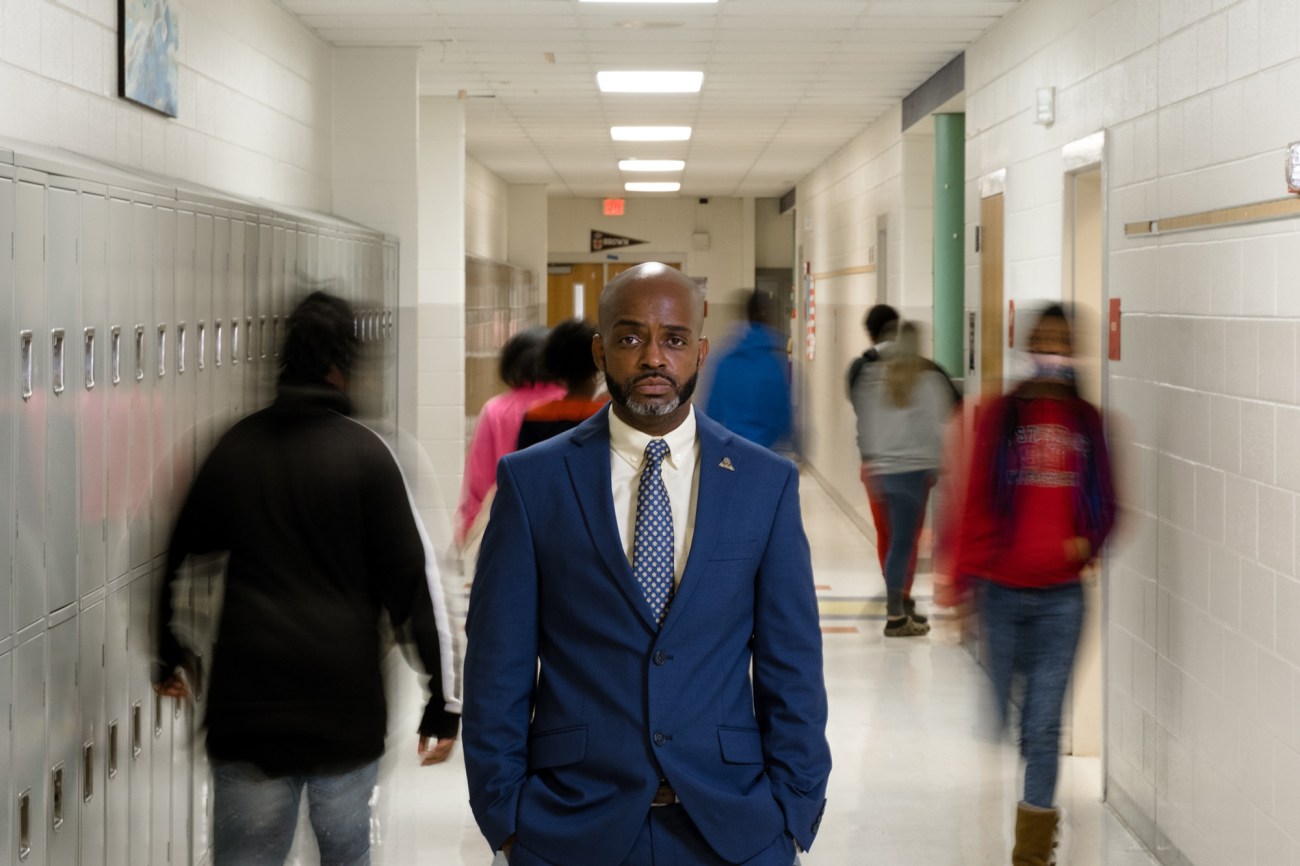
Rodney Pierce stands in the hallway of the school where he teaches social studies in Battleboro, North Carolina.
Cornell Watson
One of the most vocal opponents is Mark Robinson, the state’s first Black lieutenant governor. He has publicly denied the existence of systemic racism and started an online petition denouncing the standards which, according to him, “smack a lot of leftist dogma” and foster division. He suggests going back to the drawing board.
In March, Robinson also launched the F.A.C.T.S. (Fairness and Accountability in the Classroom for Teachers and Students) task force. It has an online portal where parents, much like police informants in another context, can share evidence of “objectionable materials” given to children.
Terry Stoops, a member of the task force and director of the Center for Effective Education at the John Locke Foundation, a Raleigh-based conservative think tank, says the goal is to assess how widespread and how much of a “substantial threat” CRT is in the classroom. They have received about 400 submissions—some of which amount to nothing more than trolling from progressives and hearsay from parents—on topics ranging from whiteness in science, colorblindness, and books by Ibram X. Kendi, the celebrated author of How to Be an Antiracist.
“It’s a mistake to see this as a witch hunt or a way to silence teachers,” he says. “CRT is just the latest in a series of alarms that have brought the issue of indoctrination in the classroom to the minds of parents. But whether it’s CRT or Trumpism, a teacher’s place is not to try to convince students to adopt their personal ideological perspectives or a certain perspective that purports to explain all American professed ideals as white supremacy.”
Stoops expects the task force’s efforts to pick up speed in the fall and suggests concerned citizens can pressure their local school boards to obliterate CRT by holding teachers “accountable under the code of ethics that says proselytizing personal viewpoints in the classroom is not allowed.” He also supports proposed legislation that would require teachers to post instructional materials online. North Carolina, Stoops says, has become “ground zero” for all discussions about race and the teaching of history. At UNC-Chapel Hill, the debate over whether to give journalist Nikole Hannah-Jones tenure—which she ultimately turned down to move to Howard University—put the state in the spotlight. It was revealed Hannah-Jones’ work on the 1619 project, a New York Times Magazine issue dedicated to depicting the importance of slavery to the founding of the United States, angered Republicans and megadonors to the journalism school.
Pierce is dealing with his own small version of what it means to be a teacher amid a political frenzy over talking about racism. As the only Black male K-12 teacher working on the revised standards, he says the resistance was to be expected considering how often the state and country’s hard history has been swept under the rug or not talked about.
“We took a lot of pride in what we did and to have people who never taught in a classroom a day in their lives questioning whether you love your country or saying the thing you put your sweat, your blood, and your tears into is divisive was insulting,” Pierce says. “A lot of our critics accuse us of not loving America, but if you love something you usually want to see it reach its full potential, and it has to be critiqued and corrected. How are we saying America is a bad country when we’re teaching what America has done?”
Here is what America is doing now. In several counties across the state there have been heated protests and attacks targeting educators and administrators. In Wilmington, New Hanover County—one of two in the state that flipped to Joe Biden in the 2020 presidential elections alongside Nash County—a demonstration outside a school board meeting in early June, which the New Hanover County GOP urged “concerned citizens” to attend, gathered a crowd of hundreds of people.
Members of a newly formed group of parents loosely organized under the name FightForOurChildren held signs that read “Teach character, not color” and distributed a black and white flyer against the teaching of CRT in public schools and the indoctrination of Marxist ideologies into “kids’ psyche.” At the bottom, the handout listed six “anti-American educators” who should be targeted for removal: four members of the local board of education, the superintendent, and Tyler Shumate, a white fifth-grade teacher at the public school Alderman Elementary in Wilmington and a member of the equity, diversity, and inclusion committee for the New Hanover County Board of Education, which oversees a district serving about 26,000 students—almost 40 percent of whom are nonwhite.
“A lot of people want us to teach that America is the greatest country that ever was, there is, and there ever will be,” said Shumate. “But that’s not American history.”
Judy Justice, one of the board members listed in the flyer, says the “dog whistles” distract from what actually matters: the students. “They think we’re indoctrinating their children, but they don’t want their children to know reality. They’re the ones indoctrinating if you ask me.”
A spokesperson for FightForOurChildren says via email that they started mobilizing during the pandemic when “virtual classrooms revealed coursework in public schools undermined core Christian beliefs and traditional family values.” They’ve made fighting CRT (a “venomous ideology guised as equity” that “will make prejudices worse”) a priority and expect to bring together more than 1,000 volunteers across different groups by the end of the year. Their message to New Hanover County Schools board members is: “Either listen to the community or step down.”
One of the vocal anti-CRT groups’ favorite targets is James Ford, who is Black and was appointed by Democratic Gov. Roy Cooper to the state board of education in 2018. He is also a former state teacher of the year and the executive director of the Center for Racial Equity in Education (CREED) in Charlotte, which offers schools and educators training to disrupt educational inequities in the state. In 2019, Pierce was selected as one of the organization’s inaugural equity fellows. He remembers Ford told them at the time that they should be prepared to receive attacks and criticism. “He’s built for it,” Pierce says. On its website, Education First Alliance North Carolina deridingly calls Ford a “vindictive Marxist” and “apostle of critical race theory, the archangel of ‘wokeness’.”
Ford says the deliberate misappropriation of terms like CRT undermines the professionalism of teachers, stops students of color from learning about themselves, and miseducates white kids who are inevitably going to raise hard questions for the communities they come from. “This is not about critical race theory,” he says. “This is about preventing the next generation of young people from investigating structural and systemic racism in any serious way, or any efforts to undo the effects of racism in the education system.”
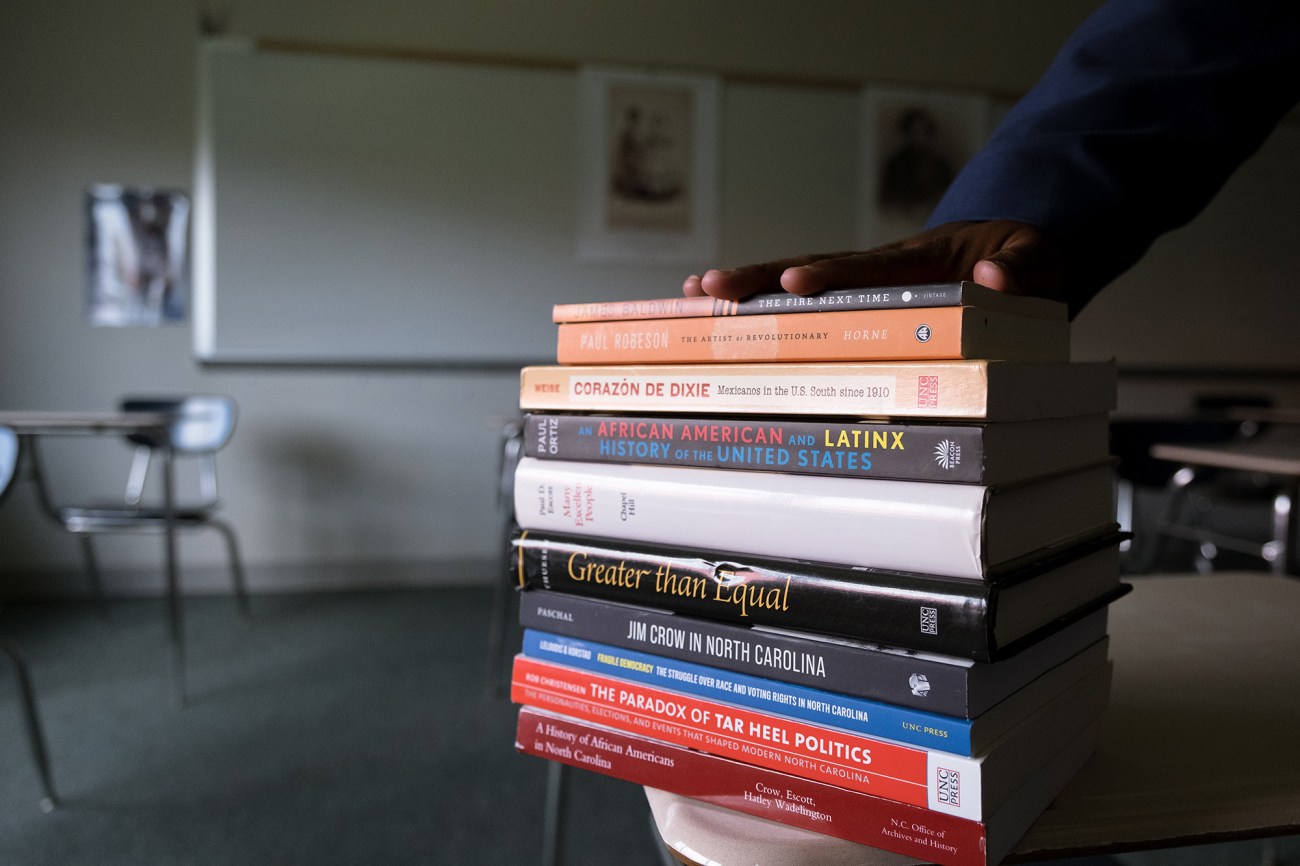
Books Rodney Pierce references in his social studies classroom include James Baldwin, “The Fire Next Time” and Paul Robeson “The Artist as Revolutionary”.
Cornell Watson
In February 2019, while teaching in Halifax County, where he still lives, Rodney D. Pierce became the North Carolina Council for the Social Studies Teacher of the Year for doing what his critics hate. The award was, at least in part, in recognition of a lesson plan he developed on Halifax County’s anti-Blackness history that encouraged students to “make connections between the county’s deep, historic anti-Black attitude for a better understanding of the current political, social, and economic conditions of its African-American residents.”
His teaching materials list a dozen lawsuits brought against racial discrimination and Jim Crow in Halifax, including that of trailblazer Sarah Keys, who refused to give up her seat on a bus years before Rosa Parks was famously arrested for defying segregation laws. In 2019, the NC Highway Historical Marker Program committee approved Pierce’s application to establish a historical marker to remember the case that outlawed segregation in interstate public transportation.
“I tell my students they have inherited a legacy of resistance,” Pierce says. “That kind of history can be empowering.”
In his classes, Pierce will also tell his students about the lynchings that happened in eastern North Carolina, a region that had some of the highest enslaved and free Black populations in the state. Through his research in newspapers archives, he learned about a man named Joe Williams, who was hanged from a pine tree in Halifax County in 1898, and shared his finding with the Red Record project, which documents lynchings in the American South. In a 2018 letter addressed to Pierce, the project director and associate professor in the Department of American Studies at UNC-Chapel Hill, Seth Kotch, praised his original contribution for making up for what would otherwise have been a “surprising omission given that historians and other researchers have gathered considerable data” on that period. He also included the information in his book Lethal State: A History of the Death Penalty in North Carolina.
For Kotch, teachers like Pierce who are investigating the legacies of enslavement in the country are doing critical and basic American history work intended to lift up communities, and not break down white people’s images of themselves. “The backlash against anti-racist education is maybe the best evidence that we have that anti-racist education is essential,” he says. “They’re building on the tradition of generations of Black anti-racist educators going back to the Antebellum era through the Civil War and Jim Crow who have had to carry out their teaching often under surveillance and hostile circumstances as an act of subversion, risking being fired or punished.
“I hope this doesn’t put a target on his back that’s even bigger than it already is, but I don’t think there’s anyone teaching in public schools in North Carolina or elsewhere who isn’t aware that they’re being watched,” Kotch says. “If teachers like Mr. Pierce are forced to surrender their academic freedom to a political movement, that will be hugely damaging to the students and to our democracy. And that’s exactly the point: to hurt our democracy by hurting our students.”
As an educator, Pierce sees his job as asking hard questions based on facts. He urges students to look at the back of a nickel and reflect on what it means to have Monticello—Thomas Jefferson’s 5,000-acre plantation in Virginia where hundreds of people were enslaved—engraved on a piece of American currency. “Do you understand how the institution of chattel slavery is ingrained in the very fabric of our country?” he asks.
When teaching about the Civil War, he encourages students to pick a side in the debate over the removal of Confederate monuments and the enactment in 2015 of a state law to keep them in place. When talking about 1968 and the assassinations of Martin Luther King and Robert F. Kennedy, he might also reference the East LA walkouts, a series of protests by Latinx students against unequal opportunities in which they demanded a more culturally responsive education. Recently, he showed his class the text of the GOP-backed “nondiscrimination” bill, HB 324, that seeks to prevent the promotion of certain concepts in schools and encouraged them to let their legislators know how they feel about it.
In the fall, Pierce, who has a bachelor’s degree in criminal justice from North Carolina Wesleyan College, will pursue a Masters of Education with a concentration in new literacies and global learning at NC State University. Looking back at the gaps of knowledge as his own “typical American education,” Pierce wonders if his teachers tried to protect him and his peers from certain parts of history. Although he can’t change that any more than he can change history, he has vowed to present his diverse body of students with a candid, full version of the facts—even if it makes some people uncomfortable.
“I’m not trying to tell them how to live their lives or what their political ideology should be,” he says. “I just want them to be critical thinkers.” These days, he sometimes thinks of this quote by the American historian Arthur M. Schlesinger, Jr.: “Honest history is the weapon of freedom.”
